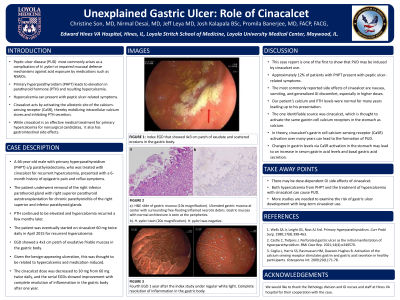Monday Poster Session
Category: General Endoscopy
P2414 - Unexplained Gastric Ulcer: Role of Cinacalcet
Monday, October 28, 2024
10:30 AM - 4:00 PM ET
Location: Exhibit Hall E

Has Audio

Christine Son, MD
Loyola University Medical Center
Maywood, IL
Presenting Author(s)
Christine Son, MD1, Nirmal Desai, MD1, Jeff Leya, MD2, Josh Kalapala, BSc3, Promila Banerjee, MD, FACG3
1Loyola University Medical Center, Maywood, IL; 2Edward Hines Jr. Veterans Affairs Hospital, Maywood, IL; 3Edwards Hines Jr. VA Hospital, Maywood, IL
Introduction: Hypercalcemia can present with peptic ulcer-related symptoms. While cinacalcet is an effective medical treatment for primary hypercalcemia, it also has gastrointestinal side effects. We present a case of cinacalcet-induced gastric ulcer.
Case Description/Methods: A 66-year-old male with a history of primary hyperparathyroidism (PHPT) who was treated with cinacalcet for recurrent hypercalcemia, presented with a 6-month history of epigastric pain and reflux symptoms. EGD showed a 4x3 cm patch of exudative friable mucosa in the gastric body. Given the benign-appearing ulceration, this was thought to be related to hypercalcemia and medication-induced, cinacalcet as the one possible culprit. The cinacalcet dose was decreased to 30 mg from 60 mg twice daily, and the serial EGDs showed improvement with complete resolution of inflammation in the gastric body after one year.
Discussion: Approximately 12% of patients with PHPT present with peptic ulcer-related symptoms (1). Our patient’s calcium and PTH levels were normal for many years leading up to his presentation, suggestive of a significant contribution from a different culprit. The one identifiable source was cinacalcet, which is thought to activate the same gastrin cell calcium receptors as calcium. In theory, cinacalcet’s gastrin cell calcium-sensing receptor (CaSR) activation over many years can lead to the formation of peptic ulcer disease (PUD) (2).
In a prior study, changes in gastrin levels in the cinacalcet-treated group were significantly higher than those in the placebo group (3), suggesting that cinacalcet’s CaSR activation in the stomach may lead to an increase in serum gastrin acid levels and basal gastric acid secretion.
This case report is one of the first to show that PUD may be induced by cinacalcet use. This case highlights that not only hypercalcemia from PHPT can cause PUD but also the treatment of hypercalcemia with cinacalcet. While cinacalcet is effective in treating hypercalcemia, more studies are needed to examine the risk of gastric ulcer development with long-term cinacalcet use.
References

Disclosures:
Christine Son, MD1, Nirmal Desai, MD1, Jeff Leya, MD2, Josh Kalapala, BSc3, Promila Banerjee, MD, FACG3. P2414 - Unexplained Gastric Ulcer: Role of Cinacalcet, ACG 2024 Annual Scientific Meeting Abstracts. Philadelphia, PA: American College of Gastroenterology.
1Loyola University Medical Center, Maywood, IL; 2Edward Hines Jr. Veterans Affairs Hospital, Maywood, IL; 3Edwards Hines Jr. VA Hospital, Maywood, IL
Introduction: Hypercalcemia can present with peptic ulcer-related symptoms. While cinacalcet is an effective medical treatment for primary hypercalcemia, it also has gastrointestinal side effects. We present a case of cinacalcet-induced gastric ulcer.
Case Description/Methods: A 66-year-old male with a history of primary hyperparathyroidism (PHPT) who was treated with cinacalcet for recurrent hypercalcemia, presented with a 6-month history of epigastric pain and reflux symptoms. EGD showed a 4x3 cm patch of exudative friable mucosa in the gastric body. Given the benign-appearing ulceration, this was thought to be related to hypercalcemia and medication-induced, cinacalcet as the one possible culprit. The cinacalcet dose was decreased to 30 mg from 60 mg twice daily, and the serial EGDs showed improvement with complete resolution of inflammation in the gastric body after one year.
Discussion: Approximately 12% of patients with PHPT present with peptic ulcer-related symptoms (1). Our patient’s calcium and PTH levels were normal for many years leading up to his presentation, suggestive of a significant contribution from a different culprit. The one identifiable source was cinacalcet, which is thought to activate the same gastrin cell calcium receptors as calcium. In theory, cinacalcet’s gastrin cell calcium-sensing receptor (CaSR) activation over many years can lead to the formation of peptic ulcer disease (PUD) (2).
In a prior study, changes in gastrin levels in the cinacalcet-treated group were significantly higher than those in the placebo group (3), suggesting that cinacalcet’s CaSR activation in the stomach may lead to an increase in serum gastrin acid levels and basal gastric acid secretion.
This case report is one of the first to show that PUD may be induced by cinacalcet use. This case highlights that not only hypercalcemia from PHPT can cause PUD but also the treatment of hypercalcemia with cinacalcet. While cinacalcet is effective in treating hypercalcemia, more studies are needed to examine the risk of gastric ulcer development with long-term cinacalcet use.
References
- Wells SA Jr, Leight GS, Ross AJ 3rd. Primary hyperparathyroidism. Curr Probl Surg. 1980;17(8):398-463.
- Castle C, Tietjens J. Perforated gastric ulcer as the initial manifestation of hyperparathyroidism. BMJ Case Rep. 2021;14(4):e240570.
- Ceglia L, Harris SS, Rasmussen HM, Dawson-Hughes B. Activation of the calcium sensing receptor stimulates gastrin and gastric acid secretion in healthy participants. Osteoporos Int. 2009;20(1):71-78.

Figure: a. Index EGD that showed 4x3 cm patch of exudate and scattered erosions in the gastric body.
b. H&E slide of gastric mucosa (10x magnification)
Ulcerated gastric mucosa at center with surrounding free-floating inflamed necrotic debris. Gastric mucosa with normal architecture is seen at the peripheries.
c. Fourth EGD 1 year after the index study under regular white light. Complete resolution of inflammation in the gastric body.
b. H&E slide of gastric mucosa (10x magnification)
Ulcerated gastric mucosa at center with surrounding free-floating inflamed necrotic debris. Gastric mucosa with normal architecture is seen at the peripheries.
c. Fourth EGD 1 year after the index study under regular white light. Complete resolution of inflammation in the gastric body.
Disclosures:
Christine Son indicated no relevant financial relationships.
Nirmal Desai indicated no relevant financial relationships.
Jeff Leya indicated no relevant financial relationships.
Josh Kalapala indicated no relevant financial relationships.
Promila Banerjee indicated no relevant financial relationships.
Christine Son, MD1, Nirmal Desai, MD1, Jeff Leya, MD2, Josh Kalapala, BSc3, Promila Banerjee, MD, FACG3. P2414 - Unexplained Gastric Ulcer: Role of Cinacalcet, ACG 2024 Annual Scientific Meeting Abstracts. Philadelphia, PA: American College of Gastroenterology.
